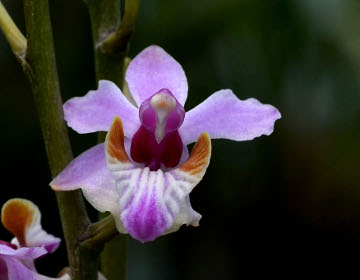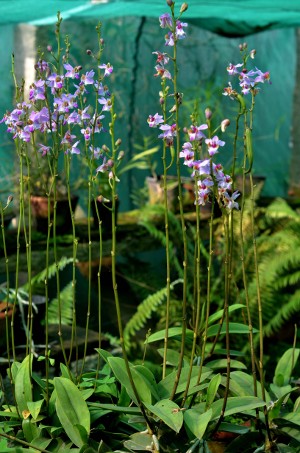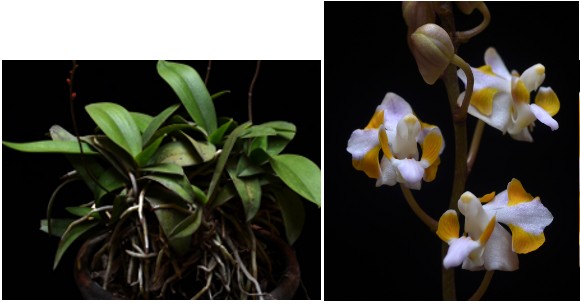Species of the Month – June 2014
Doritis pulcherrima Lindl. (= Phalaenopsis pulcherrima (Lindl).J.J.Sm

The genus Doritis is small one but unique one and is closely related to Phalaenopsis. As a result based on the DNA evidence, the genus Doritis Lindl and Kingidium P.F.Hunt are now grouped under genus Phalaenopsis as per World Check list of Selected Plant Families. However, not every one in the field accepts these changes. In his latest revision of genus Phalaenopsis, Eric Christensen has again placed Doritis in this genus. The distinguishing features between the two being the presence of mentum (chin like appearance) in Doritis and also the pollinia count is different from some of the Phals. The species Doritis pulcherrima (now known as Phalaenopsis pulcherrima) is considered to be a terrestrial in its natural habitat indicated by the erect upright inflorescence.
This is predominantly a low land species growing along the river beds in sandy soils under the shade of trees and shrubs. The name Doritis comes from the Greek word ‘Dory’ meaning ‘spear’ referring to the shape of the lip. Recently in 2010 a new species Doritis natmataungensis was found in Myanmar

Distribution: The plants are distributed in SE Asia, India, China, Myanmar, Vietnam and Indonesia.
Plant: It is a medium sized plant. The plant habit is mostly terrestrial and some are epiphytic. It is monopodial in habit and has thick leathery green leaves with purple surface underneath. The plant is unique with its roots appearing like stilt roots rising out of the media. Roots arise from the leaf axil and several off shoots are produced at the base giving an appearance of cluster of plants. Inflorescence emerges from the base of the leaves which is erect and distinguishes from Phalaenopsis and this could be due to the terrestrial habit of the plant. Plants can tolerate high light conditions. Blooms are produced during summer. Due to its wide distribution in SE Asia, there are several colour forms with varying shades. The common ones are the purple ones and the yellow colour form on the petals is a beautiful one. This is found in the Chumporn province of Thailand and thus gets its name Doritis pulcherrima var. Chumpornensis. There is another one D.pulcherrima var.buyssoniana. Now generally plants with strong growth and have larger flowers are given the varietal name.
Culture: Plant in its natural habitat grows under shade of trees and shrubs, it likes lot of light andgrowing it under 50 % shade net is preferable. It can withstand warmer temperatures of 32 C as in case of many tropical orchids. Watering thoroughly and allowing the media to dry before watering is ideal schedule. During the growth period, the plant prefers to be moist but not wet. Humidity levels of 55-60 % need to be maintained.
The plant prefers well drained media comprising of fine CHC, little coco peat, sand and charcoal. Once the plant starts growing the roots tend to show outward and this is also an indication for repotting. They prefer smaller clay pots and do not over pot the plants as they are small. Reptting can be taken up after the blooms. The spikes after the blooms fade, if cut back, may produce second set of blooms. Plants can be propagated by dividing the offshoots with roots.

2. Doritis pulcherrima var.chumpornensis
Apart from the named varieties there is plenty of hybrids produced using Doritis as a parent. The hybrids have produced some of the most wonderful colours and variations and are usually more adaptable to varying conditions in culture then the species itself.
REFERENCES
1. Wikipedia- en.wikipedia.org/wiki/Phalaenopsis
2. Ingrid Schmidt-Ostrander – Canadian Orchid Congress – www.canadianorchidcongress.ca/Ingrid/doritis.html
3. Shashidhar, K. S, 2011, Beginners Guide to grow orchids, IBH publications, Dehradun
Article by : Dr. K.S. Shashidhar
Thank you sir. Wonderful writeup on Doritis
Thanks Sriramkumar, at present it is in bloom in my collection and shortly will share the pictures
shashidhar
Saya amat meminati orkid ini tp saya baru ada satu warna iaitu purple. Dekat mana saya blh memperolehi warna lain? Tq.
Dr. Shashidhar,
You may like to reply for this query in Malay!!.
Mr-Dayang Mutiara Abg Shokeran says-
“I love this orchid but I just have one color of purple . Close to where I can obtain other colors ? TQ ”
– Satya Rao
Hi
There is another var as mentioned in the article D. pulcherrima var. champorensis which is available in Thailand
shashidhar
It was a great article Dr. I would like to know a background of this orchid if u mind to share.
Are this species is common or rare species that we can found in wild? Is this species is under pressure from collectors since its easy to propagate?
Tq Dr
Hi, thanks for the great info.
I would like to know how long does it take to flower if grown from baby.
Lovely colors
I have problem with this species, never give flower at all while it’s growing well leafs and root. It’s nearly four years now still no flowers, anyone have any ideas about that?
I have same problem. It’s growing roots but not producing flower spike . Help.